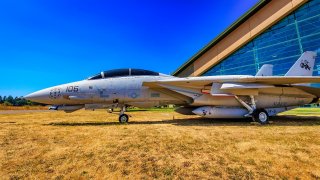The F-14 Tomcat's Phoenix Missile Made It a Powerhouse
While the Tomcat, equipped with the formidable Phoenix missile, was a very powerful airframe at the time, the platform was ultimately relegated to retirement in the early 2000s. The dissolution of the Soviet Union meant the U.S. could no longer justify the jet’s maintenance on financial grounds.
The Northrop Grumman F-14 fighter jet is perhaps most widely recognized for its role in the 1980 blockbuster film Top Gun. Capable of exceeding Mach-2.0 speeds and reaching long ranges, the formidable platform represented the best of American aerial innovation for many years.
The legendary fighter featured a whole host of cutting-edge capabilities during its service tenure with the U.S. Navy. However, its greatest asset was arguably the AIM-54 Phoenix missile.
An Overview of the Tomcat
The U.S. Navy first sought out a long-range, high-endurance interceptor aircraft during the Second World War. Specifically, the service conceptualized a platform that could defend carrier groups against Soviet bombers and other adversarial warships.
When then-Secretary of Defense Robert McNamara tasked the Navy and Airforce to come up with a joint aircraft to fulfill the needs of both services under the Tactical Fighter Experimental Program, the F-14 was ultimately born. The fighter first took to the skies in the 1970s and debuted with the fleet a few years later onboard the USS Enterprise.
Introducing the Phoenix Missile
Two powerful Pratt & Whitney TF30-P-412A engines powered the Tomcat, which could produce a combined thrust power of roughly 42,000 pounds. At this rate, the Tomcat was one of the fastest jets to fly the skies when it was introduced. The fighter was equipped with AIM-54B and later AIM-54C air-to-air missiles, and it could carry up to half a dozen Phoenix missiles.
These beyond-visual range air-to-air missiles were first produced in 1966, incorporating a semi-active radar homing and terminal phase active radar homing guidance system The AIM-54 Project was initially designed for the F-111B Aardvark airframe, the Navy’s carrier-capable variant of the F-111A. However, this project was eventually canceled, and the Phoenix would be incorporated into the Tomcat instead.
Equipped with the Phoenix, a Tomcat pilot and electronic countermeasures officer were able to engage multiple targets at long distances at the same time- an unparalleled capability at the time. As explained by analyst Harrison Kass, “The finished AIM-54 was a capable weapon. Up to six could be launched simultaneously in any weather condition, making the AIM-54 versatile and reliable. The missile was operated with an “ejection launch,” by which a pyrotechnic charge jettisons the missile from an external launch system beneath the F-14 before the AIM-54’s solid propellant rocket motor engine ignited. The AIM-54 was a heavy weapon.”
What Happened to the Tomcat?
While the Tomcat, equipped with the formidable Phoenix missile, was a very powerful airframe at the time, the platform was ultimately relegated to retirement in the early 2000s. The dissolution of the Soviet Union meant the U.S. could no longer justify the jet’s maintenance on financial grounds. As detailed by Popular Mechanics, without the presence of a “high-tech” adversarial air force there just wasn’t an urgent need for the Tomcat in the immediate post-Cold War era.
Maya Carlin, National Security Writer with The National Interest, is an analyst with the Center for Security Policy and a former Anna Sobol Levy Fellow at IDC Herzliya in Israel. She has by-lines in many publications, including The National Interest, Jerusalem Post, and Times of Israel. You can follow her on Twitter: @MayaCarlin. Carlin has over 1,000 articles published over the last several years on various defense issues.
Image Credit: Creative Commons and/or Shutterstock
From the Vault
F-35I Adir: Israel Has a Special Stealth Fighter Even America Doesn't Fly

